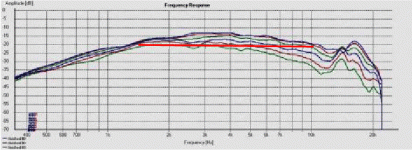I'm about to begin my first measurements/crossover design of a system with a waveguide. I was wondering if people who've worked with waveguide designs do anything different when taking measurements and designing the crossover. Here's the measurements of the tweeter on a flat baffle and in the waveguide: http://techtalk.parts-express.com/s...25-6-012-in-a-waveguide&p=1841309#post1841309 As you can see there's quite a bit of "droop" in the response off axis response for the WG compared to the flat baffle. I'm thinking if I approach this like a standard design the end result is going to sound dull/rolled off because of this. If I'm used to using on axis driver measurements for crossover design, should I use off axis measurements (let's say 30-40 degrees) for a project like this and plan on pointing the speakers more or less straight ahead? (I usually measure and listen about 5-10 degrees off axis to my non-waveguide designs.)
Last edited:
It depends on the waveguide, and your techtalk link is broken, but the answer to using 30-40° off-axis measurements is almost definitely no. If the -6dB pattern is close to constant directivity, you'll probably want a gently falling (3-6dB) response on-axis, and if the pattern is narrowing at HF maybe a more flat response on-axis.
Looks like you could treat it as an approximation of an 80° constant directivity waveguide to me. I'd design on-axis, incorporating compensation to flatten the on-axis response in your measurement to something like this below, and crossing over to where the midwoofer has an approx. 80° pattern, i.e. -6dB at +/-40°.
Attachments
Member
Joined 2009
The best way to do it is to find a woofer at the particular size where it's directivity (due to beaming) matches that of the waveguide in the proposed crossover region. You can study this design for reference:
The Seas ER18DXT ported two way
There is considerable variation for woofers' directivity but if I was to give a very general reference (for a 60degree directivity) a 10" driver should cross well to a waveguide around 1kHz, 8" @ 1.5kHz, 6.5" @ 2kHz, 5.5" @ 3kHz, 4" @ 4kHz.
The Seas ER18DXT ported two way
There is considerable variation for woofers' directivity but if I was to give a very general reference (for a 60degree directivity) a 10" driver should cross well to a waveguide around 1kHz, 8" @ 1.5kHz, 6.5" @ 2kHz, 5.5" @ 3kHz, 4" @ 4kHz.
Last edited:
To keep matters flowing, once you decide whether the drivers can be matched, and where (possibly 3k5), then you might go ahead and design a crossover in the usual way. The downward droop with the tweeter response isn't a bad thing regarding why it happens, but you should still straighten it up or maybe leave some of the downward trend if it sounds better.
Do you mean post #40 in the thread you linked?quite a bit of "droop" in the response off axis response for the WG compared to the flat baffle.
To me, it is more like the lower end of the tweeter is being boosted by the waveguide 6-8 dB, and the directivity being reoriented. Directivity seems more uniform over the tweeter operating range.
- Status
- This old topic is closed. If you want to reopen this topic, contact a moderator using the "Report Post" button.
- Home
- Loudspeakers
- Multi-Way
- Measuring and voicing waveguides v.s. flush mount tweeters
